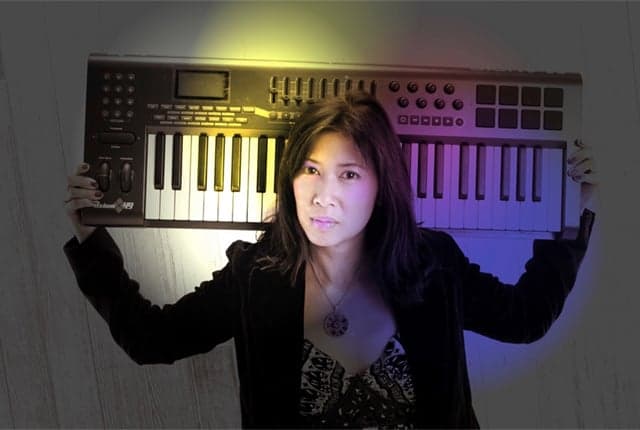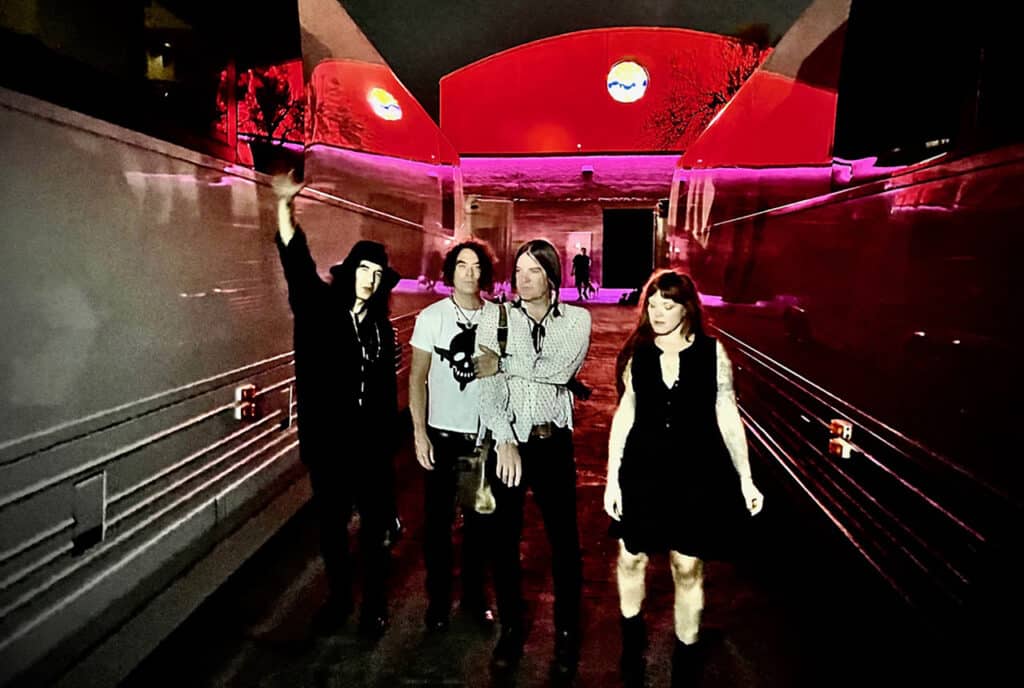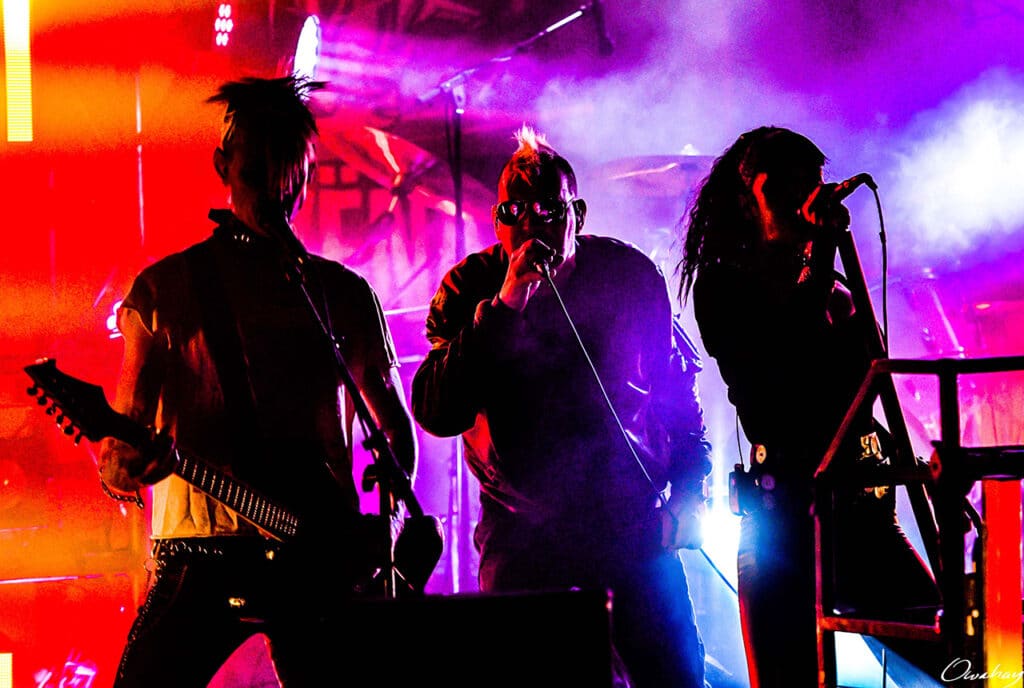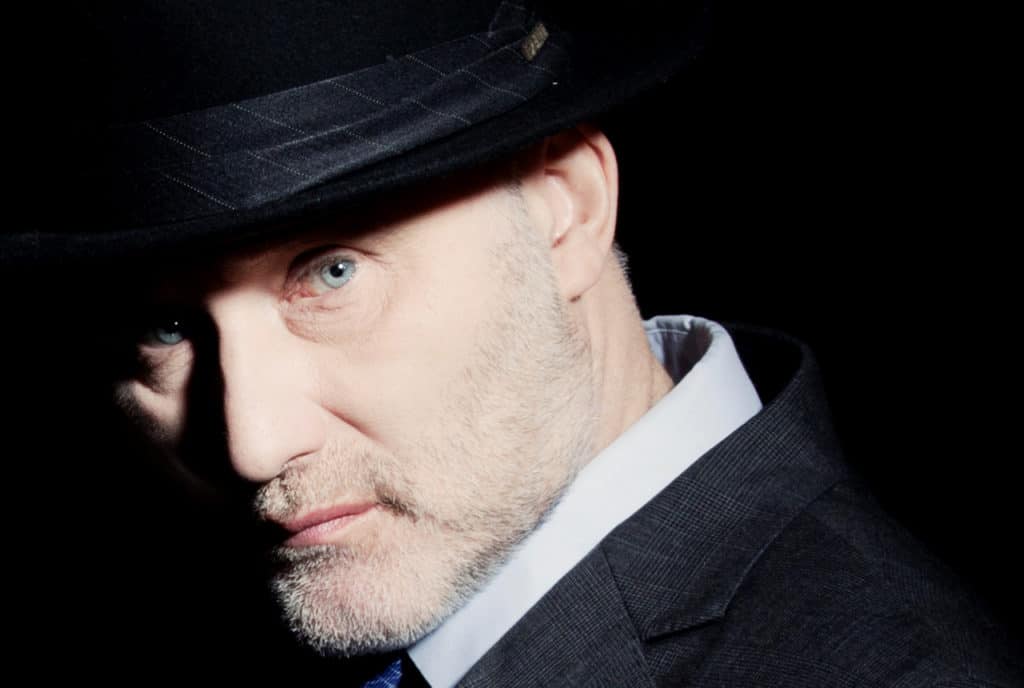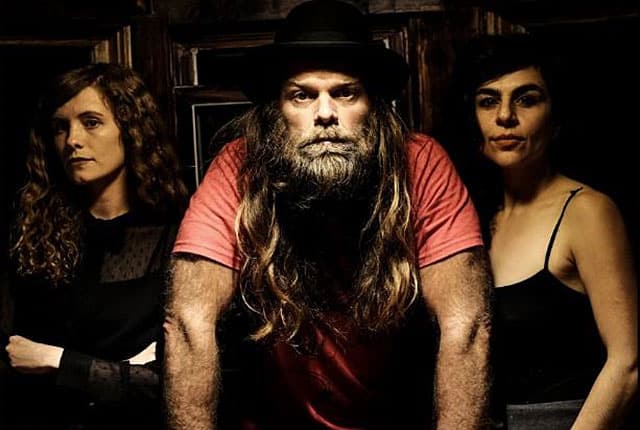The work of electronic musician Carolyn Fok spans over four decades and has ranged from aggressive industrial to more ambient soundscapes. It’s always had an experimental edge, with meticulous and highly creative sound design.
Thanks to a pair of new large-scale collections, Fok’s music is now more readily available. Specialist reissue label Dark Entries has put out a six LP vinyl box set containing all of Fok’s officially released music as CYRNAI between 1980-1990, as well as bonus materials and a comprehensive booklet. For the digital realm, Fok has put her entire archive of music (100 albums’ worth) online through her website Memoir Of Sound.
Fok’s deep interest in sound began in 1976, when at age nine she started recording stories on a tape recorder. She was soon exploring various musical instruments and effects units belonging to her father, including an early, self-built drum machine and a TEAC reel-to-reel. This lead to a lifelong fascination with sound design.
As a teenager, Fok was inspired by artists such as Cabaret Voltaire and Crass, and created the stage name CYRNAI. She had her first release, the 12″ EP ‘Charred Blossoms,’ in 1985. Between the years 1983 and 1991, she also played in San Francisco-based acts including Treason, ASOM, Trial and Rhythm and Noise. Fok later released music under her own name, such as the ambitious double CD ‘The Listener’ in 2001 and 2011’s ‘Magic Realism’ (featuring collaborations with Grammy-nominated guitarist Joaquin Lievano.)
What was the inspiration and goal behind “Memoir of Sound”?
“It’s a life statement, spanning four decades of recording that continues to amass. It points to unlimited capacities, endurance, and brain science. It’s naivety at it’s best. It’s historical in terms of listening to changes in music technology, but also journalistically. It’s gathered every recording I’ve ever done in one place, both as Carolyn Fok and CYRNAI, conscious and subconscious. But it’s also to be added to indefinitely.
“For someone who’s done all their own music, instruments, sound design, production, composing, vocals, multi-tracking, editing, spatialization, mastering, photography, video, painting, and concept, there was one solution that came to a finality as to what to do with so much work accumulated, more than 100 albums. ‘Memoir of Sound’ was like a light bulb. It’s also an investigative approach, like a 30-year film where the tape kept rolling.
“I was thinking about an AI program where you plug all your memories into a robot, and it could know everything and replay your life. You could find comfort in the past, and you could continue the future with more. The idea of ‘Memoir of Sound’ is a living library of that sort. Each of these albums has a story. The layers of sound are the events, they’re layers of paint or fingerprints or dreams that give impressions. This is the audio portion of my brain. The next to come are the written diaries since 1976.”
How did the “CYRNAI 1980-1990” box set come about?
“Strangely enough, while ‘Memoir of Sound’ was developing, there had been a territorial war from labels around the world – Amsterdam, London, New York and San Francisco. Suddenly, there was this resurgence of 80s and vinyl. It’s interesting because I had already been collecting and archiving all my work—the ‘Memoir of Sound’ work. That was remastering all the cassettes and reels and transferring the reels to digital. I was already in that process, and then it was kind of out of the blue. Maybe that is just some kind of synchronicity. I think everything I’ve done is sort of pulled on synchronicity. Josh Cheon from Dark Entries Records contacted me out of the blue as I was in the midst of doing my archiving. He wanted to reissue an album, but it went from one album to a box set and kept going from there. I would pull out things that he’d never heard and kept adding to it. I pulled out a cover of The Cure [‘In Your House’], which was done at the time the [original] record came out, in 1980 or 1981. He created a 7-inch single of it and included it in the box set. So, it was quite a process, and the designer did a really good job of putting it all together. They pretty much reissued all the known releases and then some unreleased pieces between, and then there is also a booklet. It’s a very limited release and should become rare once out of print.
“Cherry Red Records will also include an unreleased 80s track on their Close to the Noise Floor, North American Early Electronica 80s that includes The Residents, Philip Glass, Terry Riley, etc.”
Is the box set vinyl only?
“It’s just vinyl. I didn’t want digital because ‘Memoir of Sound’ is all digital, so that might compete. I wanted to take the digital territories, and he took the vinyl.”
‘Memoir of Sound’ spans your entire career, while the CYRNAI box set sticks to the 80s. Do you think you will do another physical collection?
“We’ve been in talks of doing another one for the 90s, either a double LP or a box — a period with the emergence of digital, hard industrial dance, sophisticated samples and sequencing. Some of these have never seen the light of day, or they’ve never been on vinyl. A lot of the 80’s were cassettes. Josh [Dark Entries Records] can pull from cassettes. It’s funny because he would rather print vinyl from a cassette than the original reel to reel, because it’s that mix, from that time. I found the original reels, but he didn’t want them. He wanted the cassette. Engineers would just go crazy, saying, ‘You never do it from a cassette!’ I grew up around that whole thinking back then, so now it’s funny. But Josh wants to assure people have really authentic material.”
I read that you came up with the name CYRNAI by rearranging letters in your name, but what made you decide to work under that name at the time (rather than just Carolyn Fok)?
“Around the 80s, I was getting a bachelor’s degree in illustration at the San Francisco Academy of Art College, as Carolyn Fok. I had some distant relatives who let me reside in a historic building they managed that had several theaters in it, since my school was across the street. But, I was the only tenant; the rest was commercial businesses. It was a lot of time in isolation, and I began editing my name to CYRNAI partly as a breakthrough way to endure the intensity of the states there. I was trying to be an art student, but I struggled internally. This was where music technology consumed my process and the illustrator merged together. CYRNAI was about the powerful subconscious I discovered, which seemed to have an endless wellspring of efforts that harnessed its freedom. Images, ideas, and thoughts came out in floods. I could hear silences between rhythms as much as the beat and synthesizers wove the storytelling. I did blind Step Sequence, quantize, and came up with new irregular rhythms that couldn’t be recreated. That was my inner voice.
In the beginning, were you influenced by other music or purely experimenting on your own?
“The beginning would have to be age 9 in the mid-70s when I was in New Jersey from Los Angeles. It was during that transition that my father gave me a tape recorder with a radio where I used instrumental music as backgrounds to the stories. My father, a computer system analyst, was building the PAiA drum machine that I heard at night. On the radio I heard a variety from symphonic music, short wave static, songs like ‘Someone Saved My Life’ (Elton John) and my father played Fame (Bowie) and the movie Tommy; both were very early influences. I was back to California 1.5 years later, which spawned a lot of comic character development and diaries. By age 13, I went to rock concerts, which was the start of music influences in bands that ranged from rock to punk, and later industrial. At home in the early 80s, experimenting with recording was a total vacuum. No one knew I was doing it, and I didn’t know of anyone doing it either.
“The early 80s as a teen was a time I found a lot of used instruments left around by my father. In high school, I was taking trips to San Francisco to see punk bands. It was a pretty dark period in my life, though. Later in college, I lived in an actor’s theater building that was mostly empty, so I was isolated. The experimenting was a result of having ample time and space to both reflect and soul search for years. Sounds kept me company, and then I’d add my story to carve a signature.
“My whole orientation of the music industry was a bit intuition and synchronicity. The characters that show up in any phase seemed to also be part of my life’s experiment. “
What equipment were you using on the early recordings?
“Paia Drummer Boy, Sound Master SR 88 drum machine, Mattel Electronics Synsonic Drums, Moog Opus 3, Fender guitar, gongs, Realistic Reverb Mic, Rhodes piano, violin, saxophone, clarinet, acoustic, steel, double string, ovation guitars, bass, drums, drum machines, conga, Egyptian bongos, 808, Casio keyboards, Yamaha DX-7, Roland keyboards and effects, Harmonizer, SMS, Sony Walkman recorder, etc.. I first dubbed tape recorders to each other, then discovered a Teac 4-track in the living room, and reels my father had, I erased over.”
How has the evolution of musical technology affected your creative/working process?
“There was significant evolution transpiring between 80s and 90s. It was entirely reels and cassettes from early 80s, only using mic positions to get EQ. I never used a mixing board.
“The period of discovering how to do multi-track was purely guesswork. I never cut tape. I start/stopped tape to fit as much onto a 1/4? track. I never bounced tracks either.
“I joined an industrial group that had a Synclavier in 1989, which was how I learned more about sampling and sequencing. I became an electronic drum and synth programmer, customizing note by note, just like writing letters or using a typewriter. I had a Commodore 64 computer with large floppies that basically had enough memory to loop only bits. By 1993, I had a collection of instrument samples on floppy I used with a Cazio FZ-10M sampler rack. I think I boasted 3 gigs of sound. I used to sample found objects, i.e., sheet metal, dry ice on metal, conga rhythms, violin strikes, or unique angles of objects to get natural EQ. I recorded different takes from a harmonizer with vocals. I had a Mac II. The only problem was editing every sample. If I had a shoebox full of 120 min Dat tapes of drum hits, I’d have to edit every single hit. So, I invented a software that could truncate 500 hits within a minute, called Robotic Editor. I had it upgraded to current OS, so I can still use it. My digital ‘clean’ sound was very different from the 80s past, using Studio Vision and Sample Cell, the best combinations. My more danceable pieces came from it. It was also the only time I ever tried sending demos.
“During this period, I met Nile Rodgers through a cousin who gave some advice on hits and vocals and marketing. I randomly met Trent Reznor at a club and ended up with one of his friends at the time; we stayed in Trent’s house in LA for a week during Downward Spiral’s mix. I met Marilyn Manson (Brian) sitting at the living room mixing board, about to make his first album. These experiences were unique but they were probably only synchronous. I released an 80-page book and CD, Transfiguration, later myself where it was one of the first CD/book combinations. It was one of the few releases, too, where I made a conscious effort then to pronounce the vocals, to the point of perfectionist. Every phrase was sampled and sequenced. None of it was live but sounded like it was.
“By the turn of the twenty-first century, I wanted to mature everything and released The Listener. During that phase, I had acquired knowledge though innovators on 3D sound and wanted to spatialize everything. The next thing I wanted to explore was human technology, immersing myself into significant travels to deserts and countries, and meditation for empowerment transmissions, and then composing when you’re totally illuminating. That result was the release, ‘Magic Realism.’
“At that time, a Buddhist organization bought me gear for me to mix and master their in-house music. They were in support of women, so basically, I ended up simultaneously mastering my own colossal archive bit by bit, which became ‘Memoir of Sound.’”
You’ve mentioned playing in punk and industrial band early on; are there any that you’d like to mention?
“TRIAL, on bass/vocals, was one band that artfully presented our human depth and catharsis, but it was very poetic and pure. It spoke to some part of us that was innocent but shadowed by the coming-to-age in life, to society, politics, and those complexities. My first album, “Charred Blossoms,” was done as a teen. It was similarly thought that your delicate self can easily wipe out by the eventual indoctrination process. ’But our love will save us.’ -TRIAL
“After the TRIAL album on Rough Trade, I went into a San Francisco industrial outfit where I became a synth and drum programmer on a Synclavier housed in a traffic control tower structure, in a warehouse with hanging sheet metal; we had six drummers. Audiences were blindfolded on buses and brought to the warehouse where they then had sight and we performed. The philosophical piece from TRIAL transitioned into a midnight frontier where I’d create my custom rhythms from 10pm and leave at 10am; maybe it was my comfort zone. During this time period, historically, music technology crossed over from analog to digital from 1989 to the 90s.”
You do other types of art as well. How do you see the relationship between music and visual arts?
“Some of it is synesthesia. The brain isn’t segmented in categories the way we have defined. It’s physically interwoven, and it pulls from any of its facilities, our presets. Some we don’t know about, the savant in us. The ones we don’t know about are what music and art are for. It’s trying to get to tap into the savant. Math and art can also be the same thing, i.e., seeing numbers, which can be musical. My now 7-year-old autistic son has been studied and televised around unusual savant abilities, i.e., he has memorized over 200 Pi numbers, and he needs the sense of motion when reciting. The commonality between music and visual arts is there because we are ultimately empty and ultimately endless.”
Has the evolving technology presented any challenges, for example, due to software becoming obsolete? You mentioned having used Studio Vision, which was once widely used but now discontinued.
I haven’t used Studio Vision since the 90’s. The problem with it changing all the time is that you have to change the computer, because at a certain point, it hits it’s limit. I have a dozen computers sitting around because I have to change with every step. That’s the hassle part of it. But in general, I see technology in a traditional way in that it’s always meant to aid humans, to get things done faster or easier. It’s not to replace creativity or become us. Although it’s easy for a drum machine to make you an artist, the work has got to have a unique signature, no matter what changes.. I’ve been guilty of being the fanatic and getting the new best thing. I don’t mind each change, but I think you can setup for every phase. Use the old Mac II if it works with the software, and you can utilize all these different technologies for what you need. I think you can benefit from every aspect of technology whether it’s old or new. Whether vinyl’s better or digital’s better, to me it’s just whatever you need [at the time]. I’m a plugin person. I love plugins and technology that is meant to aid you. I tend to think digital sounds better. With the right engineering and mastering, you can get even more out of digital. I can create the same thing with digital as some modular synthesizers. There are so many tools. I like having everything there. I love sound design, as an artist, I like that draw tool and I like to design visually, like a canvas in front of me. But I’m open to all of it.”
With “Memoir of Sound,” can people buy individual songs, or is it all full releases?
“When I designed the website, there was the prospect of buying each track. In older days, if you heard a hit, you bought the whole album. Because there are experimental aspects of many albums, a tape would go sequential, so it would take things out of context if you were to just get one thing. I kind of want it all in context. It’s a chronology, so I tried to make it self-explanatory in that sense. So, if they’re looking for the 80s period or whatever, then they would go look at that. It’s all pretty detailed, up to the current. I’m also going to be putting out samplers. You can preview the majority of it, but I’m also going to be releasing samplers for people to actually buy physical product. Because people can preview the music, they can randomly sample anything they want [on the site].”
What music has proven to be the most popular so far?
“So far, from the purchasers, people have really gravitated towards the 80s. It’s very interesting how that has come around. It’s come up before; some years ago, the 80s were sort of trending, but it’s so prominent right now. “
So “Memoir of Sound” is going to keep growing?
“I seem to be always moving forward. It’s always been my signature to combine sound design. I think there’s some essence of older work that I’ll pull into newer works. The next one I’m going to be planning is around the idea of birth. I recorded my son’s first breath on the table. I don’t know if I should put this in as the name of the album, but it’s called ‘The Birth Chrysalis.’ It’s intense. It could be a sweet thing, but it’s also the most bloody, intense thing. So, you can get some intensity from just that subject matter, and I want to tackle that subject. So, I’ve got this life project that I’ve just done with ‘Memoir of Sound,’ and now I’ve got this birth thing. I like to tackle intense subject matters. There’s always some kind of edge to my work. There’s a whole other side that is atmospheric, because my work has transformed over the years, so some you can even call New Age music, and the soundtrack type of music. Then there’s a harder synth pop or EDM aspect in me I love where I expect that to take over a bit. I can kind of cull from everything I’ve done and in a way, it resets the clock, ‘Memoir of Sound’ just sort of reset it. It was a birth to try to release this and produce it. It’s a birth because 90% of my work hadn’t been released so this was restarting the clock. I can move on to the next thing. That’s why this format is perfect, because I can keep adding to it.”
Speaking of soundtrack style music, have you done or thought about doing scores for films or other mediums?
“I’m always around these circles. I haven’t done that, but everyone on Earth has always pointed me to it, and I’m always trying to make those connections. It’s something I’d really love to do. I am going to be producing my own documentary and putting my music behind it. I want to exercise it a bit; I can totally see myself in it. That’s something I’d love to explore more.”
Could you elaborate on your own documentary?
“There are so many layers to the way I’ve paralleled the mediums I’ve worked with, from the 100+ albums of sound/music and instruments, artworks from childhood through adult, 50+ diaries, 80s super-8 films, videos, etc., that a Memoir of Sound documentary should try to explain the body of work. I’ve hardly done any music videos, so perhaps within the straightforward documentary, they may become dream sequences.”
Do you currently perform live?
“I have done some performing in the past. I haven’t done it recently, but I need to do it. I’m working on filling in pieces of the puzzle .”
For more info, visit:
memoirofsound.com
carolynfok.com
Cyrnai box set at darkentriesrecords.com
